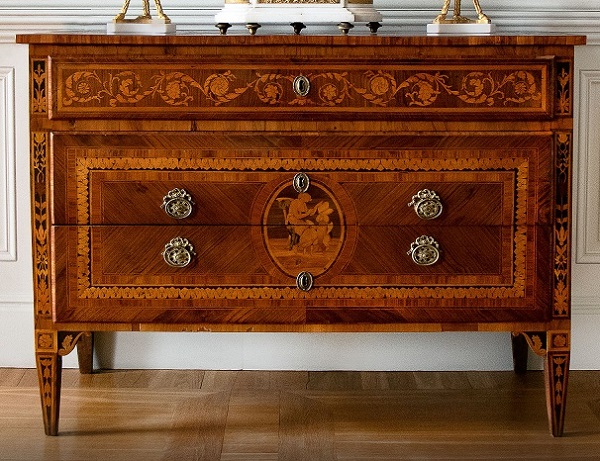Cassettoni neoclassici intarsiati attribuiti all’ebanista milanese Francesco Preda
di Andrea Bardelli
English version below
Nell’ambito degli studi sul mobile neoclassico lombardo è stato possibile isolare un gruppo omogeneo di cassettoni in numero di cinque [Figure 1/5] a cui se ne è aggiunto un sesto conservato presso il Rundāle Palace Museum a Pilsrundāle in Lettonia [Figura 6, nota 1].

Figura 1. Francesco Preda (qui attr.), cassettone neoclassico intarsiato, mercato antiquario (Milano, Giglio).

Figura 2. Cassettone neoclassico intarsiato, Lombardia (Milano), fine XVIII secolo, Cambi asta 140 n. 807.

Figura 3. Francesco Preda (qui attr.), cassettone neoclassico intarsiato, Christie’s 17.9.13 n. 473.

Figura 4. Francesco Preda (qui attr.), cassettone neoclassico intarsiato, Christie’s agosto 2020 n. 3.

Figura 5. Francesco Preda (qui attr.), cassettone neoclassico intarsiato, mercato antiquario (New York, Newel Gallery).

Figura 6. Cassettone neoclassico intarsiato, Lombardia (Milano), fine XVIII secolo, Rundāle Palace Museum (foto Anita Bistere).
A questi mobili se ne possiamo associare altri.
Ad esempio, il cassettone passato in asta da Christie’s nel 2013 (vedi ancora Figura 3) ha lo stesso medaglione, mensolina e gamba di un cassettone passato in asta presso Della Rocca nel giugno 1989 [Figura 7, vedi cerchi verdi].

Figura 7. Francesco Preda (qui attr.), cassettone neoclassico intarsiato, Della Rocca 14.6.89 n. 528.
Il cassettone di Figura 7 ha la stessa lesena (vedi ancora Figura 7, riquadro rosso) di un comodino battuto in asta da Il Ponte nel settembre 1996 [Figura 8] che, a sua volta, mostra, al centro dell’anta, un decoro molto particolare (cerchio azzurro) che si ritrova in un cassettone che appartiene alla produzione riconosciuta dell’ebanista Francesco Preda [Figura 9, nota 2].

Figura 8. Francesco Preda (qui attr.), comodino neoclassico intarsiato, Il Ponte settembre 1996 n. 350.

Figura 9. Francesco Preda, cassettone neoclassico intarsiato, Finarte marzo 1988 n. 176.
Tutti i mobili finora considerati vengono pertanto attribuiti alla bottega di Francesco Preda.
In particolare, il cassettone del Rundāle Palace Museum, di cui alla Figura 6, si connette ancor più direttamente alla produzione della bottega.
Infatti, il medaglione al centro della fronte, raffigurante Venere che istruisce Amore [Figura 6a], compare, in controparte, anche in un cassettone rientrante nell’ambito dei lavori di Francesco Preda più immediatamente riconoscibili [Figura 10].

Figura 6a. Particolare del cassettone neoclassico intarsiato di Figura 6.

Figura 10. Francesco Preda, cassettone neoclassico intarsiato, Christie’s Roma 26.5.82 n.194 n. 176.
NOTE
[1] Visita il sito del museo [vai].
[2] Su Francesco Preda si rimanda all’articolo Francesco Preda ebanista neoclassico milanese (luglio 2010) [Leggi]. Il mobile di Figura 9 è ivi riportato come Figura 3.
Ringrazio la dottoressa Agnese Tambaka del Rundāle Palace Museum per la segnalazione e per la successiva corrispondenza.
Dicembre 2023
© Riproduzione riservata
English version
Inlaid neoclassical chests of drawers attributed to the Milanese cabinetmaker Francesco Preda
In the context of studies on Lombard neoclassical furniture it was possible to isolate a homogeneous group of chests of drawers in number of five [Figures 1 to 5] to which a sixth was added conserved at the Rundāle Palace Museum in Pilsrundāle (Latvia) [Figure 6, note 1].
Fig 1. Francesco Preda (here attributed), inlaid neoclassical chest of drawers, Lombardy (Milan), late 18th century, antiques market (Milan, Giglio).
Fig 2. Francesco Preda (here attributed), inlaid neoclassical chest of drawers, Lombardy (Milan), late 18th century, Christie’s 17.9.13 n. 473.
Fig. 3. Francesco Preda (here attributed), inlaid neoclassical chest of drawers, Lombardy (Milan), late 18th century, Cambi auction n. 140 lot. 807.
Fig. 4. Francesco Preda (here attributed), inlaid neoclassical chest of drawers, Lombardy (Milan), late 18th century, Christie’s August 2020 lot. 3.
Fig. 5. Francesco Preda (here attributed), inlaid neoclassical chest of drawers, Lombardy (Milan), late 18th century, antiques market (New York, Newel Gallery).
Fig 6. Francesco Preda (here attributed), inlaid neoclassical chest of drawers, Lombardy (Milan), late 18th century, antiques market, Rundāle Palace Museum (ph. Anita Bistere).
To these pieces of furniture we can associate others.
For example, the chest of drawers auctioned by Christie’s in 2013 (see again Figure 2) has the same medallion, shelf and leg as a chest of drawers auctioned by Della Rocca in June 1989 [Figure 7, see green circles].
Fig. 7. Francesco Preda (here attributed), inlaid neoclassical chest of drawers, Lombardy (Milan), late 18th century, Della Rocca 14.6.89 lot. 528.
The same chest of drawers in Figure 7 has the same pilaster (see again Figure 7, red box) of a bedside commode auctioned by Il Ponte in September 1996 [Figure 8] which, in turn, shows, in the center of the door, a very particular decoration (blue circle) which is found in a chest of drawers which belongs to the recognized production of the cabinetmaker Francesco Preda [Figure 9, note 2].
Fig. 8. Francesco Preda (here attributed), inlaid neoclassical bedside commode, Lombardy (Milan), late 18th century, Il Ponte September 1996 lot. 350.
Fig. 9. Francesco Preda, inlaid neoclassical chest of drawers, Lombardy (Milan), late 18th century, Finarte marzo 1988 lot. 176.
All the furniture considered so far is therefore attributed to the workshop of Francesco Preda.
In particular, the chest of drawers of the Rundāle Palace Museum, shown in Figure 6, is connected even more directly to the workshop’s production.
In fact, the medallion in the center of the forehead, depicting Venus instructing Cupid [Figure 6a], also appears, in counterpart, in a chest of drawers that falls within the more immediately recognizable works of Francesco Preda [Figure 10].
Figure 6a. Francesco Preda (here attributed), inlaid neoclassical chest of drawers, Lombardy (Milan), late 18th century, antiques market, Rundāle Palace Museum (detail).
Fig. 10. Francesco Preda, inlaid neoclassical chest of drawers, Lombardy (Milan), late 18th century, Christie’s Roma 26.5.82 lot. 194.
NOTES
[1] See the Rundāle Palace Museum’s web site [go].
[2] About Francesco Preda, see the article Francesco Preda ebanista neoclassico milanese (July 2010) [Read]. The piece of furniture in Figure 9 is shown there as Figure 3.
I thank Dr. Agnese Tambaka of the Rundāle Palace Museum for pointing aut the chest of drawers and for subsequent correspondence.
December 2023
© Riproduzione riservata
